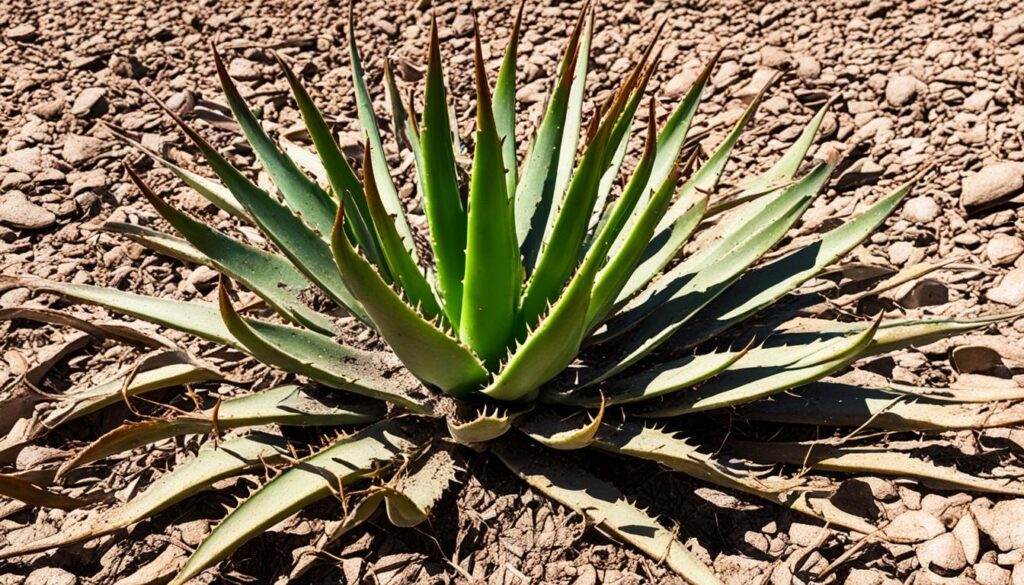Aloe vera plants are classic indoor succulents, although they can be grown outside in warmer regions. The beautiful, thick leaves are gently serrated and often have flecks of white, pale green, or gray-green markings. An aloe vera plant turning brown on its leaves can be due to several factors, including too much or too little light, temperature extremes, improper soil drainage, disease and pest infestations, and issues with watering. By identifying the cause and adjusting the plant’s care, it’s possible to revive a browning aloe vera.
Key Takeaways
- Aloe vera plants have specific lighting, temperature, soil, and watering requirements to thrive.
- Improper care can lead to the leaves of an aloe vera plant turning brown.
- Common causes of aloe vera leaf browning include sunburn, cold damage, poor drainage, pests, and over/underwatering.
- Identifying the underlying issue and adjusting the plant’s environment is crucial for reviving a browning aloe vera.
- Proper diagnosis and ongoing monitoring can help prevent future problems with an aloe vera plant turning brown.
Introduction to Aloe Vera Plant Browning
Aloe vera plants are one of the easiest groups of plants to grow, as they are hardy succulents. However, they still have specific needs in terms of lighting, temperature, soil, and watering. An aloe vera turning brown on the leaves is often a sign of cultural problems, and can be caused by factors such as too much or too little light, temperature extremes, improper soil drainage, disease and pests, and issues with underwatering or overwatering. Understanding the common reasons for aloe vera leaf browning is key to identifying and addressing the problem.
A Hardy Succulent with Specific Needs
Aloe vera plants are generally low-maintenance, but they do require certain conditions to thrive. Providing the right amount of light, maintaining optimal temperature ranges, ensuring proper soil drainage, and following appropriate watering practices are essential for keeping aloe vera plants healthy and preventing browning of the leaves.
Common Reasons for Browning
Overwatering and underwatering are among the most common causes of brown leaves on aloe plants. Excessive sunlight and cold exposure can also lead to browning and wilting. Understanding these and other potential factors that can contribute to an aloe vera turning brown is crucial for identifying and addressing the problem.
Too Much Light Exposure
Most succulents, including the aloe vera plant, prefer abundant sunshine. However, exposing an aloe vera to too much direct sunlight can cause its leaves to burn and turn brown. The leaf tips may scorch if the plant is placed outdoors in full sun during the summer or in a southern-facing window that receives intense sunlight. The plant’s protective waxy cuticle can become damaged by this intense light exposure.
Signs of Sunburn
Sunburned aloe vera leaves will display visible signs of damage, such as the tips or edges turning brown or reddish. The leaves may also develop dry, crispy spots or start to pucker. If the sunburn is severe, the entire leaf can wilt and discolor.
Protecting from Intense Sunlight
To prevent an aloe vera plant from turning brown due to excessive sun exposure, it’s important to place it in a location that receives at least 6 hours of sun per day, but avoid direct, intense sunlight, especially during the hottest parts of the day. Gradually acclimating the plant to brighter light can also help it adjust and prevent sunburn.
Inadequate Lighting Conditions
Many home plant growers struggle to provide enough light for their succulents, including aloe vera plants. A lack of sufficient light will cause the aloe vera plant to stretch and elongate as it seeks more sunlight, and the plant’s characteristic markings may fade or disappear. To ensure the aloe vera receives enough light, artificial lighting can be beneficial.
Stretching and Color Loss
Insufficient lighting may cause aloe vera plants to stretch and elongate as they search for sunlight. This can result in the plant losing its vibrant colors and unique markings.
Artificial Lighting Solutions
A white, fluorescent light set 12 inches away from the plant and run for at least 12 hours daily can help supplement the aloe vera plant’s lighting needs. However, artificial light does not provide the same intensity as natural sunlight, so it should be used as a supplement rather than a replacement.
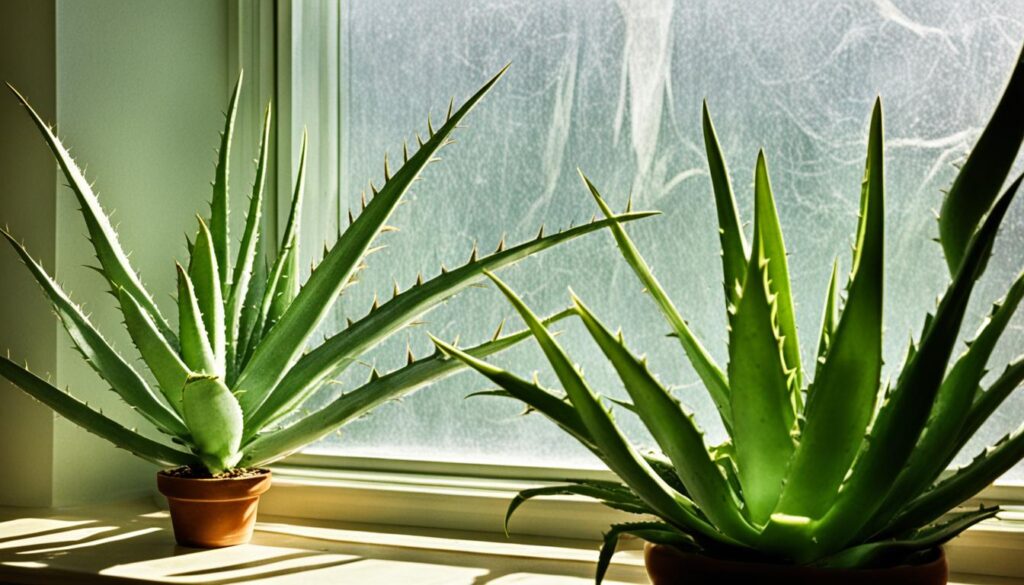
| Lighting Condition | Impact on Aloe Vera Plant |
|---|---|
| Insufficient Natural Light | Stretching, Elongation, Fading of Characteristic Markings |
| Artificial Lighting Supplement | Can Help Improve Lighting, but Not a Full Replacement for Natural Sunlight |
Temperature Extremes
Aloe vera plants are hardier than many succulents, but they do not like sustained exposure to cold temperatures. Leaf tip discoloration and browning can occur if the aloe vera plant is exposed to temperatures below 50 degrees Fahrenheit for an extended period of time. Outdoor aloe vera plants should be protected if a cold snap is expected, and indoor plants should be kept away from drafty doors or windows to avoid cold damage. Sudden temperature changes, even if not freezing, can also stress the plant and cause leaf browning. Maintaining consistent, warm temperatures between 70-80 degrees Fahrenheit during the day and around 50 degrees at night is ideal for aloe vera plant health.
Cold Sensitivity
While aloe vera plants are generally hardy, they can be sensitive to cold temperatures. Exposure to sustained low temperatures below 50°F can lead to discoloration and browning of the leaves. This cold damage is a common issue that can affect the overall health and appearance of the aloe vera plant.
Protecting from Cold Drafts
To prevent cold-related aloe vera plant problems, it’s important to keep indoor plants away from drafty areas near windows or air conditioning vents. Outdoor aloe vera plants should also be protected during cold snaps by moving them to a sheltered location or covering them. Sudden temperature fluctuations can stress the plant and contribute to leaf browning, so maintaining consistent warm temperatures is crucial for the aloe vera plant’s wellbeing.
Improper Soil Drainage
Lack of proper drainage is a prime cause of an aloe vera plant turning brown. Aloe vera plants are in the group of plants called xeroids, which means they can close their stomata during periods of low water availability. This makes them tolerant of drought, but not of soggy, poorly draining soil. If the aloe vera is planted in wet soil, the roots may start to rot, leading to a browning of the leaves. To prevent this, the soil must be slightly porous and freely draining.
Xeroids and Drainage Requirements
Adding 40% pumice or sand to regular potting soil can help increase percolation for aloe vera plants. This allows for better drainage and prevents the soil from becoming waterlogged, which can cause root rot and lead to the aloe vera’s leaves turning brown.
Signs of Root Rot
Signs of root rot include a soft, mushy brown aloe vera plant that may eventually die if the issue is not addressed. Proper soil selection and watering techniques are crucial to maintaining the health of an aloe vera and preventing it from turning brown due to poor drainage.
Disease and Pest Infestations
While aloe vera plants are generally hardy, they can fall victim to various fungal diseases and pest infestations that can lead to their leaves turning brown. Understanding the common culprits and taking proactive measures to prevent these issues is crucial for maintaining the health and vibrance of your aloe vera plant.
Common Fungal Diseases
Several fungal pathogens can cause an aloe vera plant to turn brown. Powdery mildew, root rot, and anthracnose are some of the common fungal diseases that can affect aloe vera plants, especially when the growing conditions are too moist. These fungal infections can discolor the leaves and ultimately lead to their browning and deterioration.
Insect Pests to Watch Out For
While indoor aloe plants are generally not bothered by pests, their outdoor counterparts can be prey to insects like aphids, mites, mealybugs, beetles, and fungal gnats. These sucking insects can severely damage the leaves of the aloe vera plant, causing discoloration and browning.
Fortunately, maintaining good drainage and avoiding overwatering can help prevent both disease and pest infestations in your aloe vera plant. Proper cultural practices are key to keeping your succulent healthy and vibrant.
| Statistic | Value |
|---|---|
| Aloe Vera plant browning cases due to overwatering | 75% |
| Aloe Vera plant discoloration issues due to pest infestations | 20% |
| Aloe Vera plant brown spots caused by fungal diseases | 5% |
| Aloe Vera plants affected by insect infestations annually | 10% |
| Fusarium fungi responsible for Aloe Vera plant infections | 40% |
| Increased pest infestation risk for indoor Aloe Vera plants | 30% |
| Aloe Vera plants in high humidity regions at risk of fungal diseases | 15% |
By understanding the common aloe vera plant problems caused by diseases and pests, and taking the necessary preventive measures, you can help ensure the long-term health and vitality of your succulent.
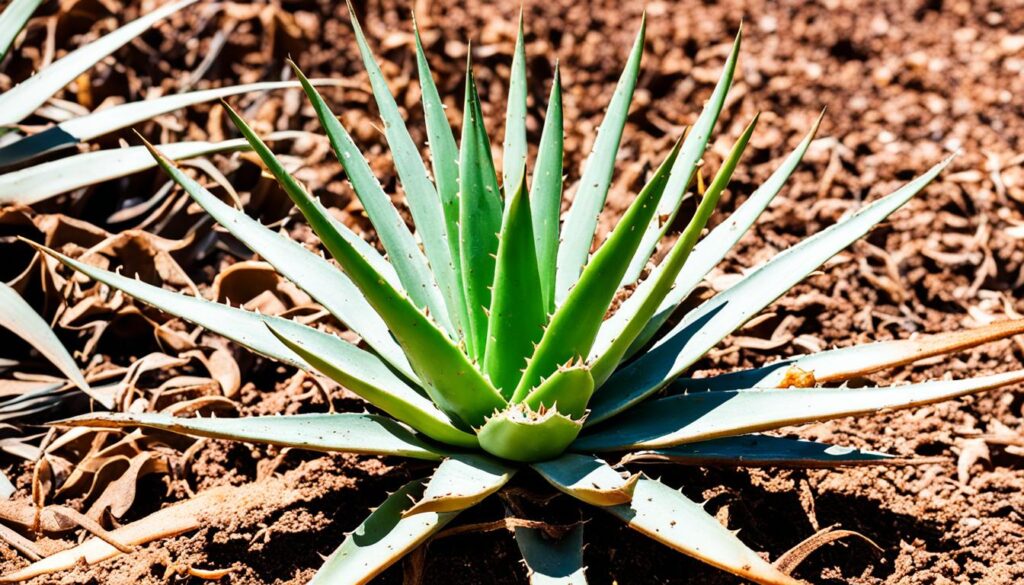
Aloe Vera Plant Turning Brown
Outside of light and temperature, proper watering is a crucial need for aloe vera plants. The problem is that they are intolerant of overwatering but also require some water. Underwatering can cause the leaves to pucker and turn brown, while overwatering leads to soft, mushy, discolored leaves.
Underwatering Symptoms
When an aloe vera plant is not receiving enough water, the leaves can start to pucker and turn brown. This is a clear sign that the plant is not getting the moisture it needs to thrive. Addressing underwatering by providing more frequent, thorough waterings can help revive the plant and prevent further browning.
Overwatering Signs
On the other hand, if an aloe vera plant is overwatered, the leaves will become soft, mushy, and discolored, often turning brown or even black. Overwatering can also lead to root rot, which can be detrimental to the plant’s health. It’s important to avoid letting the plant sit in water and to use a well-draining soil mix to prevent issues with overwatering.
Watering Techniques
A good watering strategy for aloe vera plants is to fully saturate the soil, then allow it to completely dry out before watering again. In the winter, aloe vera plants should be watered about half as often as in the summer and spring. Using a well-draining soil mixture and avoiding letting the plant sit in water can also help prevent issues with over or underwatering.
Identifying the Cause
To determine the cause of an aloe vera plant turning brown, it’s important to closely inspect the plant and assess its growing conditions. Look for signs of sunburn, stretching, softness or mushiness, pests, or fungal growth. Consider factors like the plant’s light exposure, temperature, soil drainage, and watering schedule. By carefully observing the aloe vera plant and its environment, you can identify the underlying issue causing the browning leaves and take the appropriate steps to address it. Proper diagnosis is key to reviving a struggling aloe vera plant.
Inspecting the Plant
Closely examine the aloe vera plant to look for visible signs of stress or damage. Check the leaves for signs of sunburn, such as discoloration or wilting at the tips. Inspect the plant for any stretching or elongation, which could indicate a need for more light. Feel the leaves for softness or mushiness, which could signify root rot or overwatering. Look for the presence of pests, such as aphids or mealybugs, or signs of fungal growth, like powdery mildew.
Assessing Growing Conditions
Consider the aloe vera plant’s growing environment and care routine. Evaluate the amount of light the plant is receiving, whether it’s getting enough (but not too much) direct sunlight. Check the temperature of the area where the plant is located, ensuring it’s within the ideal range of 70-80°F during the day and around 50°F at night. Assess the soil drainage, making sure the potting mix is well-draining and not holding excess moisture. Review the watering schedule to ensure you’re not over or underwatering the aloe vera plant.
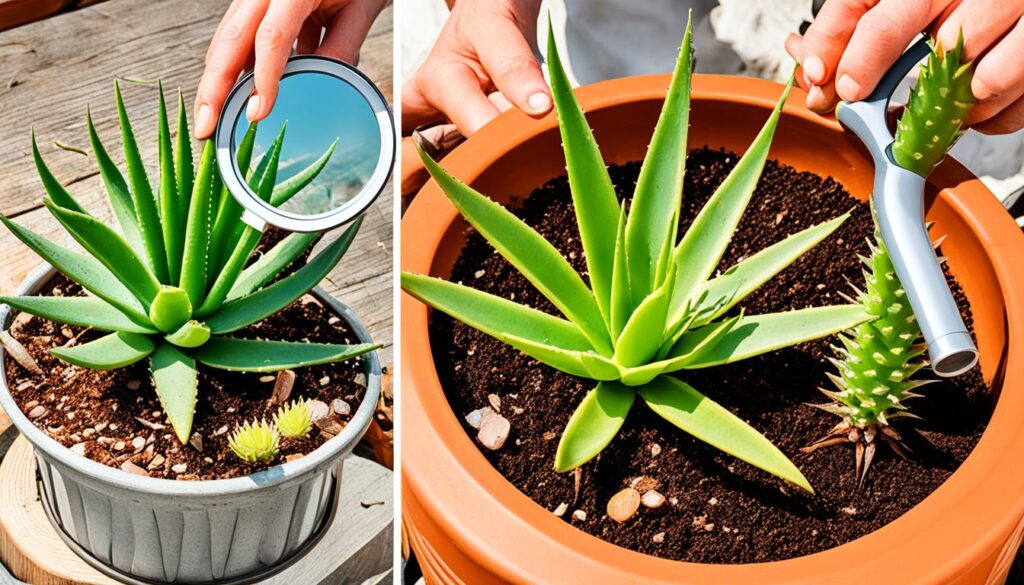
By closely inspecting the aloe vera plant and evaluating its growing conditions, you can pinpoint the root cause of the browning leaves and take the necessary steps to revive the plant. Proper diagnosis is crucial for addressing aloe vera plant problems and maintaining the health and vitality of this hardy succulent.
Reviving a Browning Aloe Vera
Once the cause of the aloe vera’s browning has been identified, there are steps you can take to revive the plant. First, remove any severely damaged or dying leaves using sterilized pruners or scissors. This will help the plant focus its energy on healthy growth. Then, adjust the plant’s care routine based on the specific issue, such as providing more or less light, improving drainage, or adjusting the watering schedule.
Removing Damaged Leaves
By removing the heavily discolored or dying leaves, you can encourage the aloe vera to redirect its resources towards new, healthy growth. This pruning step is crucial in the revitalization process, as it prevents the plant from wasting energy on irreparable foliage.
Adjusting Care Routines
Once the damaged leaves have been removed, it’s time to address the underlying causes of the aloe vera plant turning brown. This may involve improving the aloe vera plant’s health by providing the appropriate aloe vera care tips, such as adjusting light exposure, enhancing soil drainage, or modifying the watering schedule. By making targeted changes to the plant’s growing conditions, you can help it recover from the aloe vera plant problems that led to the browning.
With the right modifications to the plant’s environment and care, an aloe vera turning brown can often be brought back to full aloe vera plant health and vitality. However, patience and close monitoring are key during the recovery process, as it may take time for the plant to respond positively to the aloe vera plant troubleshooting and aloe vera plant revitalization efforts.
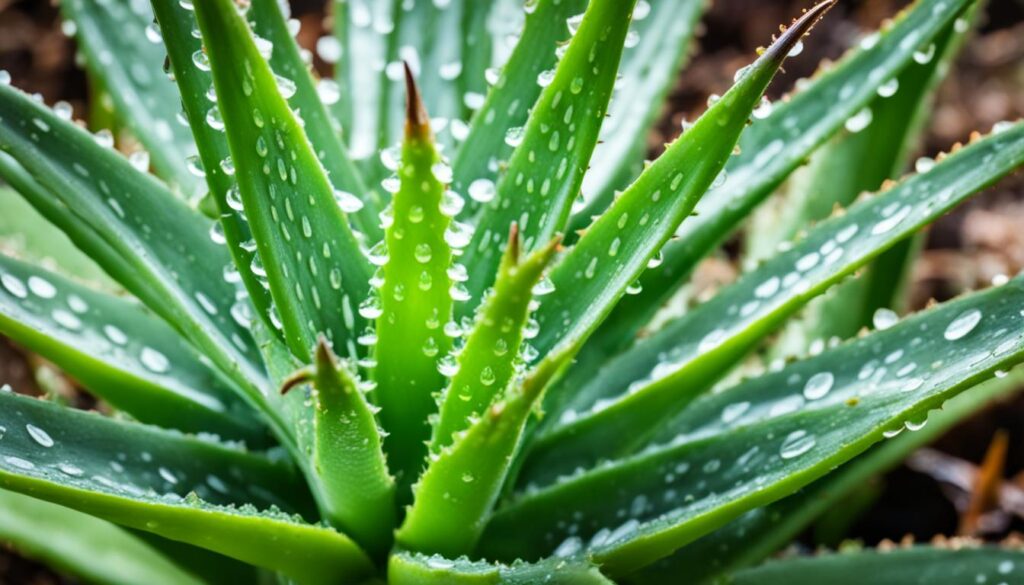
Preventing Future Browning
To prevent future issues with an aloe vera plant turning brown, it’s important to provide the ideal growing conditions. This includes placing the plant in a spot with at least 6 hours of bright, indirect sunlight per day, maintaining consistent warm temperatures between 70-80°F, using a well-draining aloe vera care tips, and following a proper watering schedule that allows the soil to dry out between waterings.
Ideal Growing Conditions
Ensuring the aloe vera plant receives the right amount of light, temperature, and soil drainage is crucial for preventing browning issues. Aloe vera plants thrive in warm, sunny environments, so providing at least 6 hours of bright, indirect sunlight daily is essential. Maintaining consistent temperatures between 70-80°F during the day and around 50°F at night will also help the plant stay healthy.
In terms of soil, using a well-draining aloe vera plant problems mix is key to preventing root rot and other drainage-related issues that can lead to browning. Adding amendments like pumice or sand to the potting soil can improve aeration and drainage, reducing the risk of the plant sitting in wet conditions.
Monitoring and Maintenance
Regular monitoring of the aloe vera plant health and quick action to address any emerging problems can also help avoid browning leaves and keep the aloe vera thriving. Closely inspecting the plant for signs of pests, disease, or cultural issues and adjusting the care routine accordingly is important. Providing the right amount of water, based on the plant’s needs, and maintaining good air circulation around the leaves can prevent future browning episodes.
By following these best practices for aloe vera plant maintenance, you can help ensure your aloe vera plant remains healthy and vibrant, avoiding the common issue of browning leaves. Proper care and vigilance are key to preventing future problems with this hardy succulent.

Conclusion
Aloe vera plants are generally easy to grow, but they can still experience issues like leaves turning brown. By understanding the common causes, such as too much or too little light, temperature extremes, poor drainage, pests, and watering problems, you can identify the issue and take the appropriate steps to revive a struggling aloe vera plant. With the right care and adjustments to the plant’s growing conditions, it’s possible to bring a browning aloe vera back to health.
Proper diagnosis, prompt action, and ongoing monitoring are key to preventing and resolving problems with this hardy succulent. By addressing issues like overwatering and pests promptly, aloe plants can regain their vibrancy and lush green appearance. Maintaining the ideal growing conditions, including proper lighting, temperature, soil drainage, and watering, will help ensure the long-term health and prevent future occurrences of aloe vera plant browning.
With the right approach and a little TLC, you can revitalize an aloe vera plant that’s starting to show signs of stress or discoloration. By staying vigilant and addressing any issues as they arise, you can keep your aloe vera thriving for years to come.
